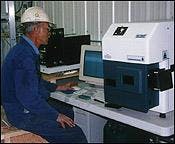In keeping with the downward dip seen at many trade shows this year, Pittcon 2002 (March 17-22; New Orleans, LA) appeared quieter than at any time in the past decade. The event remains, however, a top focus for makers and users of analytical instrumentation.
Numerous general optics and laser suppliers, particularly those that offer OEM products to analytical- and biomedical-instrument manufacturers such as Lambda Physik USA Inc. (Fort Lauderdale, FL) and Thermo Laser Science (Franklin, MA), were among the exhibitors at the show. Attracting much visitor interest was the range of lasers from Eksma Co. (Vilnius, Lithuania) on display at the booth of Altos Inc. (Hockessin, DE).
Another foreign supplier that generated interest was Bioptic Lasersysteme AG (Berlin, Germany), which showed a number of products for matrix-assisted laser-desorption ionization (MALDI) mass spectrometry, a technique of particular applicability to life-science researchers. Among the company's offerings were a high-power, short-pulse, Er:YAG solid-state laser, a tabletop ultraviolet (UV) solid-state-laser ablation system that generates high-peak-power radiation at 266 and 213 nm, and a kilohertz diode-pumped UV laser for UV-MALDI.
Analyzer wins award
Laser-based analytical instrumentation began to take its place as a reliable part of the analyst's armory with the nomination of a laser-induced breakdown spectrometer for the Pittcon Editors' Award. One of 20 new products selected by editors covering the exhibition, the compact, benchtop elemental analyzer was developed by Laser Analysis Technologies Pty Ltd. (Bayswater, Australia). The company claims that the instrument is far faster than alternative technologies, with analysis time reduced "to a matter of seconds for all the detectable elements."
The instrument incorporates an Nd:YAG laser and a parallel-processing design, which uses four Czerny-Turner spectrographs and four charge-coupled-device detectors to ensure continuous coverage from 180 to 800 nm at the resolution required to observe elemental fluorescence with minimal interference. Software enables operator control of laser energy and repetition rate as well as detector exposure. Although the product was originally developed for the analysis of lignite, the developers say that the instrument is expected to have initial applications in the minerals industry, cement and other building materials manufacturing, and metal and alloy processing.
Advanced Power Technologies Inc (APTI; Washington, DC) and Pharma Laser (Boucherville, Que., Canada) were two other suppliers of laser-induced-breakdown spectroscopy products at the show. A spin-off from Raytheon, APTI entered the market in 1998 with a laser element analyzer and has so far focused on minerals processing. The company also has been working on online systems for real-time slurry analysis and sorting analysis for rocks, plastics, and metals (see figure).
Pharma Laser started shipping instruments last year and has been targeting the rapid analysis of tablets and other solid dosage forms, which the company estimates represent 70% of all marketed drug products. The company's instrument uses a Q-switched Nd:YAG solid-state laser operating at 1064 nm with a pulse duration of 3 to 5 ns, and delivering 180 mJ on the sample at a repetition rate of up to 10 Hz. Analytical spot size is about 200 μm. The technique can be used for monitoring blend and tablet uniformity, coating thickness, and distribution of active ingredients.
Detectors make inroads
Laser-based detectors have had a tough time competing in the high-pressure-liquid-chromatography detector market, but as the need increases for higher detection limits, especially in protein work, companies such as Picometrics SA (Ramonville, France) are seeing increased interest in their products. This company extended its range of detectors with what it claims to be the first industrial deep-UV laser-induced fluorescence detector at 266 nm to detect naturally fluorescent molecules, avoiding the need for chemists to make chemical derivatives that are possible to detect.
A laser-based product was introduced by Veeco Metrology Group (Tucson, AZ), a company well-known for its scanning-probe microscopes. Veeco says its cantilever sensor-array research platform has applications in defense and security, clinical diagnostics, drug development, quality control, aroma analysis, and water- and air-quality monitoring. The system contains a cantilever coated with a material that has a selective affinity for a given substance. When the target material encounters the cantilever, it generates a mechanical signal that changes the resonant frequency of the cantilever; the resulting nanometer-scale deflection is detected by a high-resolution laser-based system.
